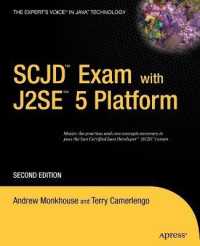- ホーム
- > 洋書
- > 英文書
- > Computer / General
Full Description
With the increasing sophistication of CAD and other design software, there is now a wide array of means for both designing and fabricating architecture and its components. The proliferation of advanced modelling software and hardware has enabled architects and students to conceive and create designs that would be very difficult to do using more traditional methods. The use of CAD technologies in the production of physical models, prototypes and individual elements is increasingly widespread through processes such as CAD/CAM, CNC milling and rapid prototyping. This translation of computer-generated data to physical artefact can also be reversed with devices such as a digitiser, which traces the contours of physical objects directly into the computer. This book focuses on the inspiring possibilities for architecture that can be explored with all the different technologies and techniques available for making complete designs or their components.
Contents
06 Introduction 14 A brief history 20 Fabricating architecture in the digital age 24 About this book 25 Getting started 26 Digital tools and machines for fabrication 30 GENERATION 32 Introduction 34 CAD 40 NURBS 44 Meshes 49 Curvilinear formations 54 Parametric and generative design 60 Algorithmic architecture 66 Morphogenesis 74 INTEGRATION 76 Introduction 77 Hybrid techniques 84 Non-standard design and mass customization 88 Digital fabrication principles 90 Laser cutting 96 CNC milling and routing 102 Rapid protoyping 108 3D scanning 111 Robotics 116 STRATEGIES 118 Introduction 120 Non-linearity and indeterminacy 121 Digital tooling 130 Contouring 140 Folding 148 Forming 158 Sectioning 166 Tiling 176 Future fabrication of architecture 184 Conclusion 186 Glossary 187 Further reading 188 Index 192 Acknowledgements








